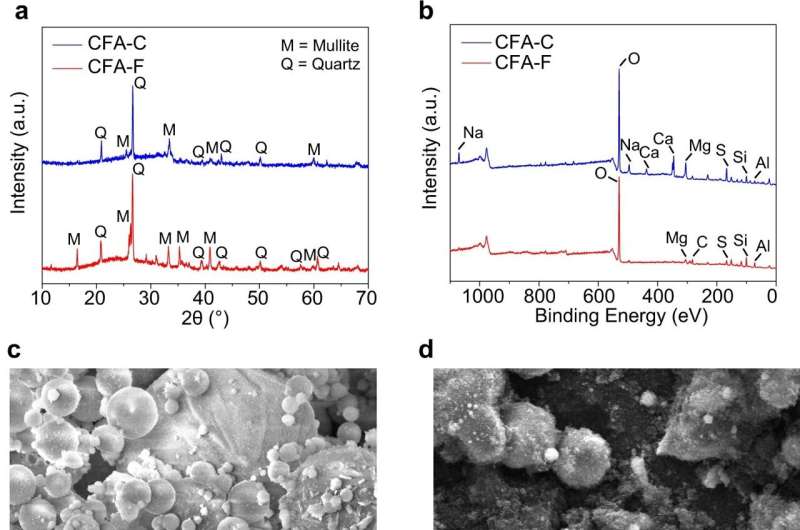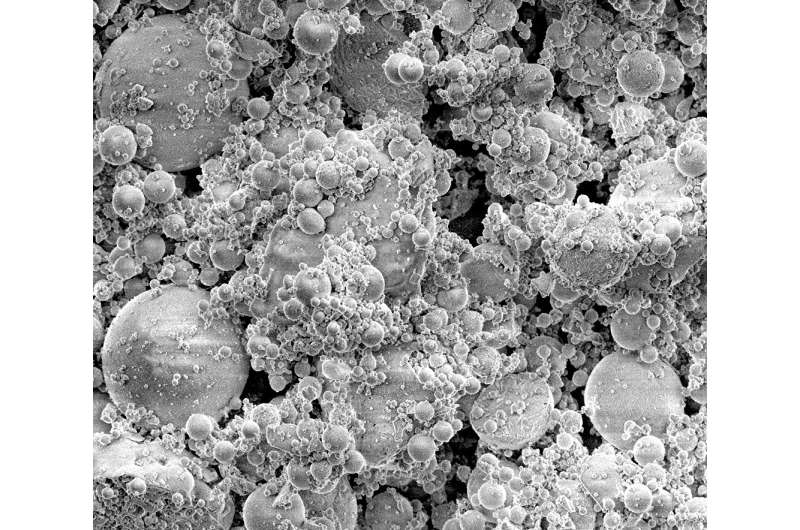This article has been reviewed according to Science X's editorial process and policies. Editors have highlighted the following attributes while ensuring the content's credibility:
fact-checked
trusted source
proofread
Eco-efficient cement could pave the way to a greener future

The road to a net-zero future must be paved with greener concrete, and Rice University scientists know how to make it.
The production of cement, an ingredient in concrete, accounts for roughly 8% of the world's annual carbon dioxide emissions, making it a significant target of greenhouse gas emissions reduction goals. Toward those efforts, the Rice lab of chemist James Tour used flash Joule heating to remove toxic heavy metals from fly ash, a powdery byproduct of coal-based electric power plants that is used frequently in concrete mixtures. Using purified coal fly ash reduces the amount of cement needed and improves the concrete's quality.
In the lab's study, replacing 30% of the cement used to make a batch of concrete with purified coal fly ash improved the concrete's strength and elasticity by 51% and 28%, respectively, while reducing greenhouse gas and heavy metal emissions by 30% and 41%, respectively, according to the paper published in Communications Engineering.
"Reducing emissions from cement production is very important to mitigate global greenhouse emissions," said lead author Bing Deng, a postdoctoral research associate in the Tour lab. "This is the big picture of this study."

Rice engineer Satish Nagarajaiah pointed out that "cement production is a significant source of carbon dioxide emissions. Reducing cement content in concrete will help reduce emissions."
"You can use less concrete if you use coal fly ash. However, fly ash contains heavy metals," Tour said. "Often, we try to fix one thing and we mess something else up. In our effort to do something with this waste, namely coal fly ash, we were polluting our environment because the heavy metals were leaching out. Water carried it into our environment and contaminated our soil along roadways, etc."
Roughly 750 million tons of coal fly ash are produced worldwide each year. Rice scientists developed a rapid and water-free process based on flash Joule heating that can remove up to 90% of the heavy metals in it, making it more fit for infrastructure use.
"Basically, we mix the fly ash with carbon black, because fly ash does not conduct electricity, and the carbon black makes the mixture conductive," Deng said. "Next, we place the mixture between two graphite or copper electrodes and use a capacitor to supply a short current pulse to the sample. This current input brings the sample temperature up to about 3,000 degrees Celsius (5,432 Fahrenheit). The high temperature makes the heavy metals evaporate into a volatile stream which is then captured.
"By using this method, we can eliminate the heavy metals from coal fly ash with very high efficiency," he continued. "For different heavy metals like arsenic, cadmium, cobalt, nickel and lead, the removal efficiency is up to 70% to 90% in just one second. This is a very rapid discharging process."
Flash Joule heating was shown to work on different coal fly ash compositions resulting from the combustion of coal extracted from various geographical locations.
"There are two main classes of fly ash with different inorganic compositions, Class C and Class F," Deng said. "We found that our method works for both kinds of coal fly ash. It also works for other hazardous wastes like red mud or bauxite residue. This shows that the process can become a generalized approach for large-scale industrial solid waste decontamination."
"The purified coal fly ash is not only better for the environment, but it also increases concrete strength and quality," said Wei Meng, a Rice civil and environmental engineering postdoctoral research associate and co-lead author on the study. "We have found that by replacing 30% of the cement in a concrete mixture with the purified coal fly ash, the compressive strength and the elastic modulus of the composite increased significantly.
"This is very meaningful for structural engineering and the construction industry because stronger structures can be built with less cement," he continued. "That is why this research is valuable to civil engineers."
The Tour lab's process allows for the evaporated heavy metals to be collected in a vacuum chamber rather than released into the environment. Moreover, the energy consumed during the process is relatively low.
"We calculated that energy consumption is about 532 kilowatts per ton," Meng said. "If we convert this to Texas electricity prices it comes out at about $21 per ton. The life cycle analysis shows we can actually extract value from these waste materials."
"It's a big win for the environment," Tour said. "You're reducing emissions, and you're not leaching heavy metals in the process."
More information: Bing Deng et al, Heavy metal removal from coal fly ash for low carbon footprint cement, Communications Engineering (2023). DOI: 10.1038/s44172-023-00062-7















